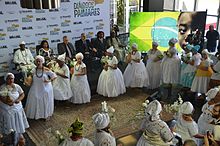Music
In Colombia, native songs and musical genres are characterized by an exchange of multiple energetic and progressive musical processes. Notable examples include bambuco, cumbia, and porro, which are examples of typical folkloric musical genres that can be traced to having an African origin, descent, or influence in style.
Bambuco
The Bambuco has a unique indigenous origin, but is also composed of a multicultural tradition. The Bambuco is established in the central Andean and Cauca area of the country of Colombia and is played by string ensembles.[14] The Bambuco combines elements of notations that fluctuate between a 6
8 or 3
4 meter, demonstrating its extreme flexibility. It can be portrayed in different instrumental variants such as the Bambuco fiestero (a faster more playful rhythm) or the contemporary Bambuco.
It is believed that the Bambuco is a musical genre that inevitability was brought by the Africans when the first slaves arrived at Cauca region.[15] There is also a relationship between Bambuco and the name of a town in French Sudan “Bambuk,” and it has been theorized that this genre comes from that specific region. Another piece of evidence is the syncopation and other forms of rhythms within the same piece of music. African music utilizes syncopated rhythms just like Bambuco does. Others theorized different appearances of Bambuco in different locations of the country, but they all coincide in an African origin or inspiration for the formation of this musical genre. For instance, on the western side of what is now Mali, a century ago, a nation named “Bambouk” existed [16] and potentially the name of bambuco was derived from this nation in Mali. In a country at the horn of Africa in Eritrea, there is a town called Bambuco. In Angola, there is a town called Bambuca and very close to that town there is another one called Cauca. Like mentioned above, the Cauca department is argued to be the place where the Bambuco genre emerged.[15]
A different branch of bambuco emerged in the Pacific Coast of Colombia, the contemporary Bambuco. The pacific coast and the northern coast of Colombia have an Afro-Colombian population that surpasses the average in comparison to any other region in the country (90% and 50%, respectively). In the region of Cauca at the coast and in between the Magdalena River, the most traditional black population is settled. Many slaves came in through the Cauca River or the Magdalena River, if they were to have come from the northern side of the country.[17] On the other hand, the argument that the Bambuco evolved in the Pacific is supported by the biggest population of Afro-Colombians in the country residing in the department of Choco, on the Pacific coast.
The Pacific coast is the only place in the country where the absolute majority is of African descent.[17] The reason for the Pacific coast’s vast majority Afro-Colombian population is not only due to its location and the rapid entrance of transportation of boats and slaves during colonization, but also due to emancipation around the year 1815. The act of emancipation led for the Pacific coast to become a refugee zone and develop into a safer place for slaves from the Choco area as well as those from the interior of the country and other urban sites throughout the country.[18] This allowed for the Afro-Colombian population to grow in this region of the country and therefore develop within certain cultural characteristics such musical genres that have African descent but are born or popularized in Colombia. With this evidence, although the Bambuco is not originally from Colombia, it became a national identity for many due to its multicultural composition. It has since spread from west to north in the country.
Cumbia
The cumbia is another typical Colombian musical genre that emerged from the African slaves in Colombia. In this case, cumbia is a mixture of rhythms from Afro-Colombians and indigenous native Colombiansto bring about a different style. Unlike the Bambuco, cumbia certainly originated in the northern part of Colombia, and its instrumentation is the key evidence of its origin, as well as its dances. Particular to cumbia, a typical Spanish dress was adapted to available native resources. In the present day, it is culturally significant enough to know about cumbia, and it is a concern to preserve it. The main festival that celebrates cumbia nowadays is the Festival de la Cumbia in El Banco, Magdalena. In order to preserve this folkloric rhythm, this genre is celebrated yearly in the Colombian coastal region.
Champeta
Throughout the years, the African heritage in music has been evolving from bambuco to porro to cumbia to champeta. Champeta is the more modern rhythm inspired by African culture and music style. The Champeta is born through a blend of African and Caribbean rhythms, including the cumbia.
The name champeta is derived by a form of Bowie knife that only low income, rural workers, usually people of African descent, would use due to their low socioeconomic status. These Bowie knives are used to cut the grass, and keep yards or streets clean, and therefore this musical genre is associated with a status and also race.[20] This genre is native to the northern coast and experimentation with many new rhythms is common. Thus a lot of commerce emerged around these varying new rhythms and much more music has become available from the African continent. This is another example of the multicultural composition of musical genres due to the diaspora throughout the country of Colombia.

